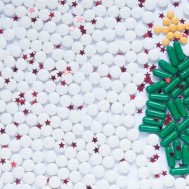Advancements in technology are truly changing the way humans think about their health. Though it may be hard to believe we’re already looking at the year in review, 2017 was no exception to this progress.
In fact, one study showed that only 41 percent of millennials said they view a doctor as the best source of health information. Where are younger generations putting their trust? You guessed it, the internet. The population’s trust in technology continues to be on the rise, and one way that’s manifesting itself is in medical technology.
Though the passage of another year may be bittersweet to some, the medical field is one area where there continues to be hopeful about where we’re headed.
Here are some of the best medical inventions of this year.
1. The artificial pancreas
In order to regulate their blood sugar levels, patients with diabetes have to inject themselves with two types of insulin: basal and bolus. Medtronic’s artificial pancreas features the only insulin pump that’s approved by the FDA, the MiniMed 670 G.
The MiniMed uses an algorithm and takes in real time data in order to automatically release basal insulin to Type 1 diabetes patients during the day. The pancreas is not yet fully automated, as patients still have to manually request bolus insulin at meal times.
However, taking away the hassle attached to basal insulin injections makes a huge difference for those with diabetes. Claire, a 14-year-old with Type 1 Diabetes, says the system gives her “the freedom to focus on the many priorities I need to juggle in my life.”
2.Watson (IBM’s supercomputer)
IBM’s Artificial Intelligence system, fondly dubbed Watson, is changing both the way that medical information is managed and how patients are examined.
It essentially accompanies the work of physicians, consolidating an individual’s records to personalized reports, rather than a physician having to read through dozens of papers per patient.
Watson’s intelligence was developed to notice trends within the data that he stores. When provided with the records of 1,000 cancer patients, Watson’s suggested treatment plans matched actual oncologist recommendations in 99 percent of cases.
3. Vocal biomarkers
This year, the research of Israeli company Beyond Verbal revealed that the analysis of human voices may be helpful for early detection of medical conditions. The company identified roughly 3 million emotion-labeled “voices” in more than 40 different languages.
This science has proven that vocal intonations can provide an understanding of emotions, health conditions, and overall well- being. Coronary artery disease, specifically, is one medical condition that has been proven to have a connection to vocal biomarkers.
In the case of CAD, which is the leading cause of death in adults in developed countries, an early detection via vocal biomarkers could be of extreme value because this disease can begin as asymptomatic.
4. Lead-free pacemakers
The need for the development of a lead-free pacemaker stemmed from complications that can occur from pacemaker leads, the wire that transports energy from the device to the human heart.
Common problems with leads include malfunctions, tissue buildup at the ends of the wire, infections, and interference with the energy transfer — all of which usually result in leads having to be removed and replaced.
Trials of Micra’s leadless pacemaker this year saw a success rate of 99.6 percent and a low rate of major complications (1.51 percent, when monitored 30 days post implant).
5. Advances in 3D imaging
3D medical imaging is not a new concept, but the way in which medical professionals can utilize this software continued to improve in 2017. This 3D imaging means that students do not need cadavers to practice on, and physicians can experiment with different procedures in real time.
There’s a projected shortage in the number of physicians entering the workforce (by around 70,000 doctors). Therefore, the need to optimize medical training processes is immense.
True 3D by Echopixel is one of the most advanced programs of the year, distinguished by the way tissues and organs pop out of the screen. Anatomy instantaneously responds to user engagements, such as grasping, removing and dissecting.
6. Breath sampling to detect lung cancer
Since lung cancer is the deadliest form of cancer in adults around the world, new developments in its early detection are quite significant in the medical community. Research shows that concentrations of exhaled breath reveal an individual’s exposure to cigarette smoke, pollution and radiation, among other carcinogens.
The breath samples of 56 patients were examined, 28 of whom who were diagnosed with lung cancer. Breath sample analysis compared to traditional diagnosis showed a 79.3 percent successful distinction between cancer and noncancer samples.
The research is still exploratory at this point, because it’s not possible to identify a single specific breath marker for lung cancer. However, there is solid evidence to say that lung cancer alters the chemical composition of one’s breath. Both simple and noninvasive breath samples would be seen as a favorable means of early lung cancer detection.
7. New drug approved to treat ALS
The Food and Drug Administration approved a new drug to treat ALS this year, the first to be endorsed by the FDA since 1995. Also known as Lou Gehrig’s disease, amyotrophic lateral sclerosis (ALS) is a progressive neurodegenerative that can cause eventual paralysis and death.
The average lifespan after ALS symptoms develop is between two and five years. General awareness about this condition was raised in 2014, after the ALS Ice Bucket Challenge was popularized on social media.
The new drug is Radicava, also known as edaravone, which acts to protect against oxidative stress, a factor in the disease’s progression. Clinical trials in Japan support the possibility that the drug may slow the decline in function of those affected by around one-third.
Medical inventions in 2017
What are some of your favorite medical innovations from this past year? Where do you think medical technology is headed? Let us know by connecting with us on Twitter @AppleRubber.
